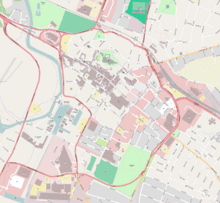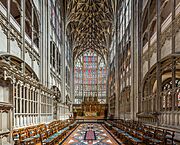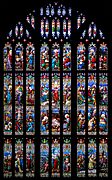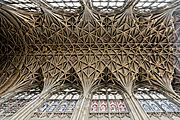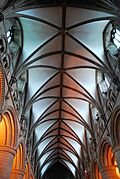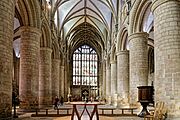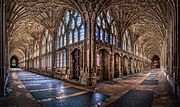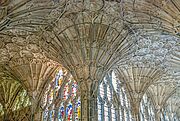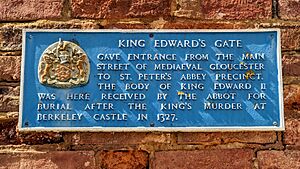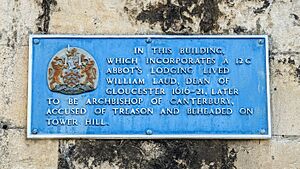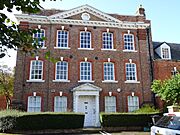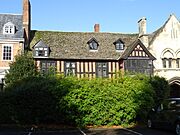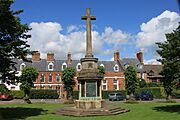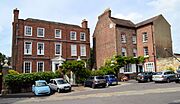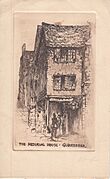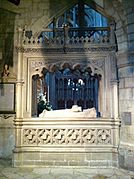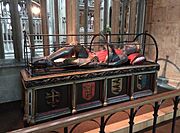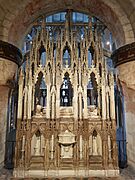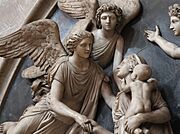Gloucester Cathedral facts for kids
Quick facts for kids Gloucester Cathedral |
|
|---|---|
| Cathedral Church of St Peter and the Holy and Indivisible Trinity |
|
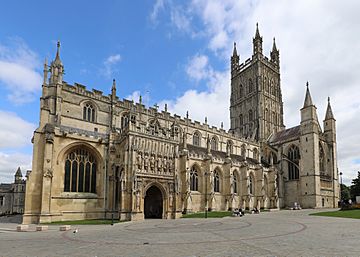 |
|
| 51°52′03″N 2°14′48″W / 51.8675°N 2.246667°W | |
| Location | Gloucester, Gloucestershire |
| Country | |
| Denomination | Church of England |
| Previous denomination | Roman Catholic |
| History | |
| Status | Active |
| Dedication | St Peter Holy Trinity |
| Consecrated | 15 July 1100 |
| Architecture | |
| Functional status | Formerly abbey, dissolved 1540. Cathedral since 1541. |
| Heritage designation | Grade I listed building |
| Style | Romanesque, Gothic |
| Groundbreaking | 1089 |
| Completed | 1482 |
| Specifications | |
| Length | 426 ft 6 in (130.00 m) |
| Nave length | 174 ft (53 m) |
| Choir length | 140 ft (43 m) |
| Nave width | 34 ft (10 m) |
| Width across transepts | 144 ft (44 m) |
| Nave height | 68 ft (21 m) |
| Choir height | 86 ft (26 m) |
| Number of towers | 1 |
| Tower height | 225 ft (69 m) |
| Administration | |
| Diocese | Gloucester (since 1541) |
| Province | Canterbury |
Gloucester Cathedral is a very old and beautiful church in Gloucester, England. Its full name is the Cathedral Church of St Peter and the Holy and Indivisible Trinity. It used to be called St Peter's Abbey. This amazing building is located in the north of the city, close to the River Severn.
The cathedral began as a small church called a minster around the year 679. It was founded by Osric, a king of the Hwicce people. Over many centuries, the church grew and changed. It became a Benedictine monastery in the 11th century. The building you see today was started by Abbot Serlo in 1089, after a big fire.
Gloucester Cathedral is famous for many things. It has been a filming location for the Harry Potter movies, standing in for Hogwarts. It also has some of the earliest examples of fan vaulting, a special kind of ceiling design. In 2015, Rachel Treweek became the first woman to be appointed a diocesan bishop in the Church of England here. The cathedral is a Grade I listed building, which means it's a very important historic site.
Contents
History of Gloucester Cathedral
Early Beginnings
The first church on this spot was a minster, founded by King Osric of Hwicce around 679. His relative, Kyneburg, became the first abbess, a leader of the nuns. The church grew, but the nuns later left due to civil unrest in England.
Later, in 1022, the Benedictine rule was introduced, and the church became an abbey dedicated to St Peter. The early buildings were damaged by fire. Around 1058, Ealdred, the Bishop of Worcester, rebuilt the church a bit further from its original spot.
The main building we see today was started by Abbot Serlo in 1089. He was appointed by William the Conqueror in 1072. When Serlo arrived, there were only two monks and eight new monks. A big fire in 1088 made things even harder.
Royal Connections and Growth
Despite the challenges, Gloucester remained important to the royal family. In 1085, William the Conqueror held his Christmas court here. During this time, he ordered the creation of the Domesday Book, a famous survey of England. With royal support, Abbot Serlo began a huge rebuilding project in 1089. The nave, apse, crypt, and chapter house were built quickly and on a large scale.
The abbey continued to have strong royal ties. In October 1216, Henry III was crowned here after his father, King John, died. Henry was only nine years old.
A sad event in 1327 also brought fame to the abbey. King Edward II was buried here after he died at nearby Berkeley Castle. Many believed he was murdered. People came from all over to visit Edward's shrine, bringing money to the abbey. This money helped pay for more building work, including the famous cloisters.
From Abbey to Cathedral
In 1536, King Henry VIII closed down many monasteries in England. This was called the dissolution of the monasteries. However, Gloucester Abbey was saved. In 1541, Henry VIII made it a cathedral for the new Diocese of Gloucester. John Wakeman, the last abbot of Tewkesbury, became its first bishop.
During the English Civil War, the cathedral was on the side of the King. Luckily, it was not badly damaged. In the 18th and 19th centuries, the cathedral had many repairs and updates. In 1989, it celebrated its 900th birthday.
In 2015, Rachel Treweek became the Bishop of Gloucester. She was the first woman to be appointed a bishop in the Church of England. The cathedral is also working to be more eco-friendly. In 2016, it installed solar panels on its roof. This made it the oldest cathedral in the UK with a solar installation.
Architecture of the Cathedral
Main Building Design
Gloucester Cathedral has a mix of styles. It started as a Norman building, and then many parts were added in different Gothic architecture styles. The cathedral is about 420 feet (128 meters) long and 144 feet (44 meters) wide. It has a beautiful central tower from the 15th century that is 225 feet (68 meters) tall.
The crypt, nave, and chapter house are from the late 11th century. The crypt is one of only four apsidal cathedral crypts in England. The nave was started in 1089, and the church was mostly finished by 1100.
In 1222, a fire damaged the roof. To fix this and update the style, new building work began. This included rebuilding the nave ceiling in the Early English style and building the central tower.
The south aisle was rebuilt between 1318 and 1329. The most important monument here is the tomb of King Edward II. The money from pilgrims visiting his tomb helped pay for new work on the south and north transepts, and the choir. The Norman walls of the choir were covered with Perpendicular designs. The ceiling of the choir is very detailed with many ribs and bosses.
The Great East Window, finished in 1350, was the largest window in the world at that time. It still has some of its original medieval stained glass. One window is thought to show the earliest images of the game of golf. Another carving shows people playing a ball game, which might be one of the earliest pictures of medieval football.
The cloisters are north of the nave. They have special areas called carrels where monks would study and write. The tomb of Robert Curthose, William the Conqueror's eldest son, is also here. He was a big supporter of the abbey.
Between 1873 and 1897, the cathedral was carefully restored by George Gilbert Scott. The cathedral has 46 misericords from the 14th century. These are small carvings on the underside of choir stalls, showing all sorts of things like myths, daily life, and folklore.
Cloisters and Surroundings
The cloisters at Gloucester Cathedral have the oldest surviving fan vaults in England. They were designed between 1351 and 1377. Many people say they are the most beautiful in England, and perhaps the first and best in the world.
The cloisters are located north of the cathedral. The area around the cathedral, called the precincts, also has many historic buildings. The Great Cloister, Little Cloister, and Little Cloister House are all very important listed buildings.
Other important buildings in the precincts include the Chapter house and the Treasury with the library above it. These buildings date back to the 11th century and have been rebuilt over time.
Some parts of the precincts are now used by King's School, Gloucester. These include parts of the Abbott's lodgings and other old houses.
-
The Great Cloister
College Green and Miller's Green
College Green is the open area to the south and west of the cathedral. It used to be a graveyard for the monks. In the 18th century, many buildings around it were changed into homes.
Miller's Green is another area to the north of the cathedral. It used to be where the monastery's service buildings were. Both College Green and Miller's Green have many historic buildings.
You can enter College Green through St Michael's Gate, which is from the 14th century. King Edward's Gate, from the 16th century, is also here. Many of the houses around College Green are also very old and listed as historic buildings.
Miller's Green is entered through the Inner Gateway. This gateway is from the 14th century and was the entrance to the monastic service area. Other buildings on Miller's Green include the Deanery and the Old Mill House.
Music at Gloucester Cathedral
The Choir
For hundreds of years, daily worship at the cathedral has included singing. The current choir was started by King Henry VIII in 1539. Today, it has 18 boy choristers, 20 girl choristers, and 12 adult singers. The young choristers attend King's School, which Henry VIII also founded. The choir sings regularly and performs in concerts. They have even been featured on BBC Radio 3.
The Organ
The cathedral's first organ was built in 1666. Its original wooden case is still complete, which is very rare for an organ from the 17th century. The pipes you see on the front are still working! Over the years, many famous organ builders have worked on it. The organ was completely rebuilt in 1888-1889 by Henry "Father" Willis. It was updated again in 1920 and 1971. In 2023, the organ is being worked on again and will be ready for the next Three Choirs' Festival in 2026.
Three Choirs Festival
Gloucester Cathedral is one of three cathedrals that take turns hosting the Three Choirs Festival. The other two are Worcester and Hereford. This festival is the oldest annual music festival in the world!
Clock and Bells
The Clock
The cathedral's clock, bells, and chimes were first mentioned in a repair agreement from 1525. The clock you see today was installed in 1898 by Dent and Co. This company also built the clock for Big Ben in London. There isn't a clock face on the outside, but there's a beautiful Art Nouveau clock face inside the north transept, designed in 1903.
The Bells
The bells were rehung and added to in 1978, making a set of twelve bells. The two oldest bells are from before 1420, meaning they are even older than the tower itself! The cathedral's bell ringers ring them regularly. There is also a very large bell called Great Peter. It weighs almost three tons and is the biggest medieval bell in Britain. Great Peter rings to mark the hour and before important services.
Famous Burials and Monuments
Gloucester Cathedral is home to many tombs and monuments from different time periods. Some of the notable people buried here include:
- Osric, the king who founded the first church here.
- Robert Curthose, the eldest son of William the Conqueror.
- Edward II of England, a King of England who died in 1327.
- John Wakeman, the last abbot of Tewkesbury and the first Bishop of Gloucester.
- Members of the Hyett family from the 17th and 18th centuries, whose remains were found by accident in 2015.
- Edward Jenner, a famous physician who created the smallpox vaccine.
-
Tomb of Osric, King of the Hwicce
-
Tomb of Robert Curthose
-
Tomb of Edward II of England
-
Tomb of Thomas Machen
-
Detail of monument to Sarah Morley by John Flaxman
Gloucester Cathedral in Film and TV
The cathedral has been a popular place for filming movies and TV shows. It was used as a stand-in for Hogwarts in the first, second, and sixth Harry Potter movies. Other productions filmed here include:
- Doctor Who episodes like The Next Doctor and Fugitive of the Judoon.
- The Hollow Crown
- Wolf Hall
- The Sherlock special The Abominable Bride
- Mary Queen of Scots
- The The White Queen, The White Princess, and The Spanish Princess series.
Academic Use
Gloucester Cathedral is also used for important events by local universities and schools.
- Degree ceremonies for the University of Gloucestershire and the University of the West of England (through Hartpury College) are held here.
- During school terms, The King's School, Gloucester holds assemblies at the cathedral.
- Other schools like Denmark Road High School, Crypt Grammar School, Sir Thomas Rich's School, and Ribston Hall High School also use the cathedral for events.
Timeline of Key Events
- 678-79: A small religious community was started by Osric of the Hwicce. His sister Kyneburga was the first abbess.
- 1017: The monastery was given to Benedictine monks.
- 1072: Serlo, the first Norman abbot, was appointed by William I.
- 1089: The first stone of the new abbey church was laid.
- 1100: St Peter's Abbey was officially opened.
- 1216: Henry III had his first coronation here.
- 1327: Edward II was buried here.
- 1331: The quire was remodeled in the Perpendicular style.
- 1373: The Great Cloister began construction.
- 1450: The Tower began construction.
- 1470: The Lady Chapel was rebuilt.
- 1540: The abbey was closed down.
- 1541: It was reopened as a cathedral by Henry VIII.
- 1666: The Great Organ by Thomas Harris was installed.
- 1847–1873: Major restoration work began.
- 1989: The cathedral celebrated its 900th anniversary.
- 1994: Restoration of the tower was completed.
- 2000: Celebration of 900 years since the abbey's opening.
- 2015: Rachel Treweek became the Church of England’s first female diocesan bishop.
See also
 In Spanish: Catedral de Gloucester para niños
In Spanish: Catedral de Gloucester para niños


